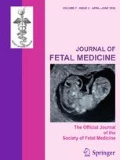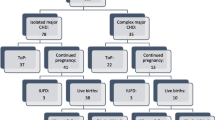Abstract
The primary objective of the study was to present a 5-year data on the outcomes after prenatal diagnosis of CHD. This is a retrospective descriptive study, conducted in the fetal medicine unit of an academic tertiary care referral centre in South India. The details of all cases with a prenatal diagnosis of fetal cardiac lesions from January 2012 through December 2016 were collected. All cases were systematically analyzed for type of lesion, associated malformations, chromosomal abnormalities, prognosis of the lesion, the decision taken by the couples and the information regarding post natal outcome, wherever available. Prenatally diagnosed fetal cardiac lesions were identified in 310 cases. In 220 (76.1%) cases, the couple opted for termination of pregnancy. In this group, 52% of them had an isolated cardiac defect with good prognosis. In the rest of the 69 cases who decided to continue, 7 cases had an IUD. In the 62 cases that culminated in a live birth, 46 cases opted for postnatal cardiac care. Corrective surgery was attempted in 18 neonates with 2 resulting in neonatal death. Prenatal diagnosis of isolated CHD provides an opportunity for an improved immediate neonatal outcome. A thorough evaluation for extracardiac and genetic abnormality will facilitate better utilization of health care resources by triaging patients with isolated CHD having good prognosis for targeted postnatal care. Also, antenatal pediatric cardiology counselling will enable the couple to make decisions regarding postnatal management options.



Similar content being viewed by others
References
Hoffman JI, Kaplan S. The incidence of congenital heart disease. J Am Col Cardiol. 2002;39(12):1890–900.
Wigton TR, Sabbagha RE, Tamura RK, Cohen L, Minogue JP, Strasburger JF. Sonographic diagnosis of congenital heart disease: comparison between the four-chamber view and multiple cardiac views. Obstet Gynecol. 1993;82(2):219–24.
Grandjean H, Larroque D, Levi S. The performance of routine ultrasonographic screening of pregnancies in the Eurofetus Study. Am J Obstet Gynecol. 1999;181(2):446–54.
Queisser-Luft A, Stopfkuchen H, Stolz G, Schlaefer K, Merz E. Prenatal diagnosis of major malformations: quality control of routine ultrasound examinations based on a five-year study of 20 248 newborn fetuses and infants. Prenat Diagn. 1998;18(6):567–76.
Wren C, Reinhardt Z, Khawaja K. Twenty-year trends in diagnosis of life-threatening neonatal cardiovascular malformations. Arch Dis Child Fetal Neonatal Ed. 2008;93(1):F33–5.
Abu-Harb M, Hey E, Wren C. Death in infancy from unrecognised congenital heart disease. Arch Dis Child. 1994;71(1):3–7.
International Society of Ultrasound in Obstetrics & Gynecology. Cardiac screening examination of the fetus: guidelines for performing the ‘basic’ and ‘extended basic’ cardiac scan. Ultrasound Obstet Gynecol. 2006;27(1):107.
Attaining Millennium development goals in India. Infant and Child mortality. http://webcache.googleusercontent.com/search?q=cache:0q8fNLAoUsAJ:siteresources.worldbank.org/INTINDIA/Resources/Intro-Infant%26Child_Mortality.pdf+&cd=1&hl=en&ct=clnk&gl=in. Accessed on November 2017.
Carvalho JS, Mavrides E, Shinebourne EA, Campbell S, Thilaganathan B. Improving the effectiveness of routine prenatal screening for major congenital heart defects. Heart. 2002;88(4):387–91.
Garne E, Stoll C, Clementi M. Evaluation of prenatal diagnosis of congenital heart diseases by ultrasound: experience from 20 European registries. Ultrasound Obstet Gynecol. 2001;17(5):386–91.
Hunter S, Heads A, Wyllie J, Robson S. Prenatal diagnosis of congenital heart disease in the northern region of England: benefits of a training programme for obstetric ultrasonographers. Heart. 2000;84(3):294–8.
Gardiner HM. Fetal echocardiography: 20 years of progress. Heart. 2001;86(suppl 2):ii12–122.
Tegnander E, Eik-Nes SH. The examiner’s ultrasound experience has a significant impact on the detection rate of congenital heart defects at the second-trimester fetal examination. Ultrasound Obstet Gynecol. 2006;28(1):8–14.
Sharland G. Fetal cardiac screening and variation in prenatal detection rates of congenital heart disease: why bother with screening at all? Future Cardiol. 2012;8(2):189–202.
Allan L. Antenatal diagnosis of heart disease. Heart. 2000;83(3):367.
Tegnander E, Williams W, Johansen OJ, Blaas HG, Eik-Nes SH. Prenatal detection of heart defects in a non-selected population of 30 149 fetuses—detection rates and outcome. Ultrasound Obstet Gynecol. 2006;27(3):252–65.
Bonnet D, Coltri A, Butera G, Fermont L, Le Bidois J, Kachaner J, Sidi D. Detection of transposition of the great arteries in fetuses reduces neonatal morbidity and mortality. Circulation. 1999;99(7):916–8.
Jaeggi ET, Sholler GF, Jones OD, Cooper SG. Comparative analysis of pattern, management and outcome of pre-versus postnatally diagnosed major congenital heart disease: a population-based study. Ultrasound Obstet Gynecol. 2001;17(5):380–5.
Vaidyanathan B, Kumar S, Sudhakar A, Kumar RK. Conotruncal anomalies in the fetus: referral patterns and pregnancy outcomes in a dedicated fetal cardiology unit in South India. Ann Pediatr Card. 2013;6(1):15.
Allan LD, Apfel HD, Printz BF. Outcome after prenatal diagnosis of the hypoplastic left heart syndrome. Heart. 1998;79(4):371–3.
Sharland GK, Lockhart SM, Chita SK, Allan LD. Factors influencing the outcome of congenital heart disease detected prenatally. Arch Dis Child. 1991;66(3):284–7.
Tennstedt C, Chaoui R, Körner H, Dietel M. Spectrum of congenital heart defects and extracardiac malformations associated with chromosomal abnormalities: results of a seven year necropsy study. Heart. 1999;82(1):34–9.
Haak MC, Bartelings MM, Groot GD, Van Vugt JM. Cardiac malformations in first-trimester fetuses with increased nuchal translucency: ultrasound diagnosis and postmortem morphology. Ultrasound Obstet Gynecol. 2002;20(1):14–21.
Hafner E, Schuchter K, Liebhart E, Philipp K. Results of routine fetal nuchal translucency measurement at weeks 10–13 in 4233 unselected pregnant women. Prenat Diagn. 1998;18(1):29–34.
Chaoui R, Körner H, Tennstedt C, et al. Prenatal diagnostizierte Herzfehlbildungen und assoziierte Chromosomenaberrationen. Ultraschall Med. 1996;17:17.
Gembruch U, Bald R, Redel D, et al. Bedeutung der pränatalen Diagnostikangeborener Herzfehler. In: Jahrbuch der Gynäkologie und Geburtshilfe. Munich: Biermann-Verlag; 1991. p. 107–18.
Allan LD, Cook A, Sullivan I, Sharland GK. Changing birth prevalence of the hypoplastic left heart syndrome as a result of fetal echocardiography. Lancet. 1991;337:959–63.
Holland BJ, Myers JA, Woods CR. Prenatal diagnosis of critical congenital heart disease reduces risk of death from cardiovascular compromise prior to planned neonatal cardiac surgery: a meta-analysis. Ultrasound Obstet Gynecol. 2015;45(6):631–8.
Author information
Authors and Affiliations
Corresponding author
Rights and permissions
About this article
Cite this article
Devadasan, S., Balakrishnan, B., Batra, M. et al. Trends and Outcomes After Prenatal Diagnosis of Congenital Cardiac Defects: Experience of a Dedicated Fetal Medicine Centre from South India. J. Fetal Med. 5, 225–231 (2018). https://doi.org/10.1007/s40556-018-0186-y
Received:
Accepted:
Published:
Issue Date:
DOI: https://doi.org/10.1007/s40556-018-0186-y




